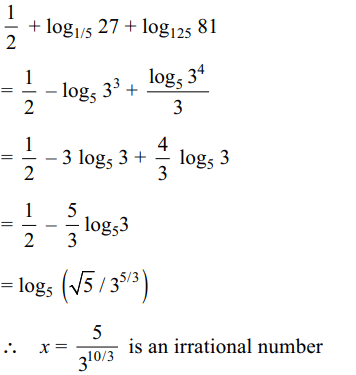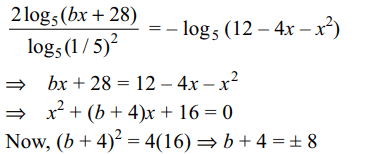1. If \[ S=\left\{x\epsilon N
:2+\log_{2}\sqrt{x+1}>1-\log_{1/2}\sqrt{4-x^{2}}\right\}\]
then
a) \[ S=\left\{1\right\}\]
b) \[ S=\phi\]
c) S = N
d) none of these
Explanation:

2. If \[\left(x+1\right)^{\log_{10}\left(x+1\right)}=100\left(x+1\right)\] then
a) all the roots of the equations are positive real number
b) all the roots lie in the interval (0,100)
c) all the roots lie in the interval [-9/10,99]
d) none of these
Explanation:

3. The value of \[\left(\log_{3}11\right)\left(\log_{11}13\right)\left(\log_{13}15\right)\left(\log_{15}27\right)\left(\log_{27}81\right)\]
is
a) 2
b) 1
c) 4
d) 3
Explanation: Use change of base.
4. The value of \[x=25^{\left(1/2+\log_{1/5}27+\log_{125}81\right)}\] is
a) 4/81
b) 1
c) a rational number
d) a irrational number
Explanation:

5. If \[\frac{\log_{1/2}x}{b-c}=\frac{\log_{1/2}y}{c-a}=\frac{\log_{1/2}z}{a-b}\] then the value of \[x^{a}y^{b}z^{c}\]
is
a) 1/2
b) xyz
c) \[\left(1/2\right)^{abc}\]
d) 1
Explanation:

6. If \[\log_{10}x+\log_{10}y=2 , x-y=15\] then
a) (x, y) lies on the line y = 4x + 3
b) (x, y) lies on \[y^{2}=4x\]
c) (x, y) lies on x=4y
d) (x, y) lies on 4x=y
Explanation:

7. If \[\frac{\left(\log_{e}x\right)^{2}-3\log_{e}x+3}{\log_{e}x-1}< 1\] then x belong to
a) (0,e)
b) (1,e)
c) (e,1)
d) none of these
Explanation:


8. The value of b for which the equation \[2\log_{1/25}\left(bx+28\right)=-\log_{5}\left(12-4x-x^{2}\right)\]
has coincident roots if
a) b=-12
b) b=4
c) b=4 or b=-12
d) b=-4 or b=12
Explanation:

9. If \[0< x< \pi/2\] and \[\cos x=\frac{3}{\sqrt{10}}\] then the value of \[\log_{10}\sin x+\log_{10}\cos x+\log_{10}\tan x\]
is equal to
a) 0
b) 1
c) -1
d) none of these
Explanation:

10. The solution set of \[\log_{2}\mid 4-5x\mid>2\] is
a) \[\left(8/5,\infty\right)\]
b) \[\left(4/5,8/5\right)\]
c) \[\left(-\infty,0\right)\cup\left(8/5,\infty\right)\]
d) none of these
Explanation:
